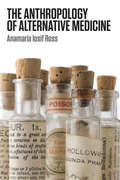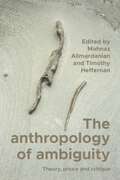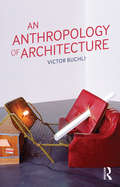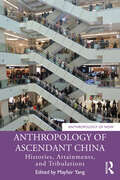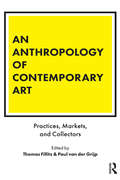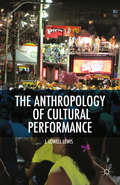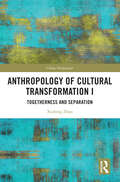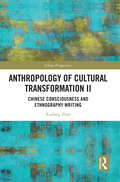- Table View
- List View
The Anthropology of Alternative Medicine
by Anamaria Iosif RossAlternative medicine is not a fashionable new trend but an established cultural strategy, as well as a dynamic feature of mainstream contemporary medicine, in which elements of folk traditions are often blended with western scientific approaches.The Anthropology of Alternative Medicine is a concise yet wide-ranging exploration of non-biomedical healing. The book addresses a broad range of practices including: substance, energy and information flows (e.g. helminthic therapy); spirit, consciousness and trance (e.g. shamanism); body, movement and the senses (e.g. reiki and aromatherapy); as well as classical medical traditions as complements or alternatives to Western biomedicine (e.g. Ayurveda). Exploring the cultural underpinnings of contemporary healing methods, while assessing current ideas, topics and resources for further study, this book will be invaluable to undergraduate and graduate students in anthropology, sociology, psychology, and health related professions such as nursing, physical and occupational therapy, and biomedicine.
The Anthropology of Alternative Medicine
by Anamaria Iosif RossAlternative medicine is not a fashionable new trend but an established cultural strategy, as well as a dynamic feature of mainstream contemporary medicine, in which elements of folk traditions are often blended with western scientific approaches.The Anthropology of Alternative Medicine is a concise yet wide-ranging exploration of non-biomedical healing. The book addresses a broad range of practices including: substance, energy and information flows (e.g. helminthic therapy); spirit, consciousness and trance (e.g. shamanism); body, movement and the senses (e.g. reiki and aromatherapy); as well as classical medical traditions as complements or alternatives to Western biomedicine (e.g. Ayurveda). Exploring the cultural underpinnings of contemporary healing methods, while assessing current ideas, topics and resources for further study, this book will be invaluable to undergraduate and graduate students in anthropology, sociology, psychology, and health related professions such as nursing, physical and occupational therapy, and biomedicine.
The anthropology of ambiguity
by Mahnaz Alimardanian Timothy HeffernanThis volume puts ambiguity and its generative power at the centre of analytical attention. Rather than being cast negatively as a source of confusion, bewilderment or as a dangerous portent, ambiguity is held as the source of the dynamic between knowledge and experience and of certainty amid uncertainty. It positions human life between the realms of mystery and mastery where ambiguity is understood as the experience and expression of life and part of navigating the human condition. In turn, the tension between the tradition in anthropology of examining cultural certitudes through ethnographic description and efforts to challenge dominant expressions of incertitude are explored. Each chapter presents ethnographic accounts of how people engage individually and collectively with the self, the other, human-made institutions and the more-than-human to navigate ambiguity in a world affected by viral contagion, climate change, economic instability, labour precarity and (geo)political tension.
The anthropology of ambiguity
by Mahnaz Alimardanian and Timothy HeffernanThis volume puts ambiguity and its generative power at the centre of analytical attention. Rather than being cast negatively as a source of confusion, bewilderment or as a dangerous portent, ambiguity is held as the source of the dynamic between knowledge and experience and of certainty amid uncertainty. It positions human life between the realms of mystery and mastery where ambiguity is understood as the experience and expression of life and part of navigating the human condition. In turn, the tension between the tradition in anthropology of examining cultural certitudes through ethnographic description and efforts to challenge dominant expressions of incertitude are explored. Each chapter presents ethnographic accounts of how people engage individually and collectively with the self, the other, human-made institutions and the more-than-human to navigate ambiguity in a world affected by viral contagion, climate change, economic instability, labour precarity and (geo)political tension.
An Anthropology of Architecture
by Victor BuchliEver since anthropology has existed as a discipline, anthropologists have thought about architectural forms. This book provides the first overview of how anthropologists have studied architecture and the extraordinarily rich thought and data this has produced.With a focus on domestic space - that intimate context in which anthropologists traditionally work - the book explains how anthropologists think about public and private boundaries, gender, sex and the body, the materiality of architectural forms and materials, building technologies and architectural representations. Each chapter uses a broad range of case studies from around the world to examine from within anthropology what architecture 'does' - how it makes people and shapes, sustains and unravels social relations.An Anthropology of Architecture is key reading for students of anthropology, material culture, geography, sociology, architectural theory, design and city planning.
An Anthropology of Architecture
by Victor BuchliEver since anthropology has existed as a discipline, anthropologists have thought about architectural forms. This book provides the first overview of how anthropologists have studied architecture and the extraordinarily rich thought and data this has produced.With a focus on domestic space - that intimate context in which anthropologists traditionally work - the book explains how anthropologists think about public and private boundaries, gender, sex and the body, the materiality of architectural forms and materials, building technologies and architectural representations. Each chapter uses a broad range of case studies from around the world to examine from within anthropology what architecture 'does' - how it makes people and shapes, sustains and unravels social relations.An Anthropology of Architecture is key reading for students of anthropology, material culture, geography, sociology, architectural theory, design and city planning.
The Anthropology of Art: A Reader (Wiley Blackwell Anthologies in Social and Cultural Anthropology)
by Morgan Perkins Howard MorphyThis anthology provides a single-volume overview of the essential theoretical debates in the anthropology of art. Drawing together significant work in the field from the second half of the twentieth century, it enables readers to appreciate the art of different cultures at different times. Advances a cross-cultural concept of art that moves beyond traditional distinctions between Western and non-Western art. Provides the basis for the appreciation of art of different cultures and times. Enhances readers’ appreciation of the aesthetics of art and of the important role it plays in human society.
Anthropology of Ascendant China: Histories, Attainments, and Tribulations (Anthropology of Now)
by Mayfair YangThis volume represents the latest research in cultural anthropology on an ascendant and globalizing China, covering the many different dimensions of China’s ascendancy both within China itself and beyond.It focuses not only on the real and perceived successes of China in the past four decades, but also on the difficulties, tensions, and dangers that have emerged as a result of rapid economic development: class polarization, state expansion, psychological distress, and environmental degradation. Including contributions by some of the most well-known cultural anthropologists of China, as well as rising innovative younger scholars, this book documents and analyzes China’s multifaceted transformations in the modern era—both within Chinese society and in Chinese relations with the outside world. It features the unique perspective of anthropology, with its on-the-ground deep cultural immersion through long-term fieldwork, coupled with a macrolevel global perspective, a strong historical perspective, and theoretically engaged analyses to present a balanced account of China’s ascendancy.Anthropology of Ascendant China: Histories, Attainments, and Tribulations is suitable for students and scholars in Anthropology, Sociology, History, Political Science, and East Asian Studies, as well as those working on contemporary Chinese society and culture more broadly.
Anthropology of Ascendant China: Histories, Attainments, and Tribulations (Anthropology of Now)
This volume represents the latest research in cultural anthropology on an ascendant and globalizing China, covering the many different dimensions of China’s ascendancy both within China itself and beyond.It focuses not only on the real and perceived successes of China in the past four decades, but also on the difficulties, tensions, and dangers that have emerged as a result of rapid economic development: class polarization, state expansion, psychological distress, and environmental degradation. Including contributions by some of the most well-known cultural anthropologists of China, as well as rising innovative younger scholars, this book documents and analyzes China’s multifaceted transformations in the modern era—both within Chinese society and in Chinese relations with the outside world. It features the unique perspective of anthropology, with its on-the-ground deep cultural immersion through long-term fieldwork, coupled with a macrolevel global perspective, a strong historical perspective, and theoretically engaged analyses to present a balanced account of China’s ascendancy.Anthropology of Ascendant China: Histories, Attainments, and Tribulations is suitable for students and scholars in Anthropology, Sociology, History, Political Science, and East Asian Studies, as well as those working on contemporary Chinese society and culture more broadly.
An Anthropology of Biomedicine
by Margaret Lock Vinh-Kim NguyenIn this fully revised and updated second edition of An Anthropology of Biomedicine, authors Lock and Nguyen introduce biomedicine from an anthropological perspective, exploring the entanglement of material bodies with history, environment, culture, and politics. Drawing on historical and ethnographic work, the book critiques the assumption made by the biological sciences of a universal human body that can be uniformly standardized. It focuses on the ways in which the application of biomedical technologies brings about radical changes to societies at large based on socioeconomic inequalities and ethical disputes, and develops and integrates the theory that the human body in health and illness is not an ontological given but a moveable, malleable entity. This second edition includes new chapters on: microbiology and the microbiome; global health; and, the self as a socio-technical system. In addition, all chapters have been comprehensively revised to take account of developments from within this fast-paced field, in the intervening years between publications. References and figures have also been updated throughout. This highly-regarded and award-winning textbook (Winner of the 2010 Prose Award for Archaeology and Anthropology) retains the character and features of the previous edition. Its coverage remains broad, including discussion of: biomedical technologies in practice; anthropologies of medicine; biology and human experiments; infertility and assisted reproduction; genomics, epigenomics, and uncertain futures; and molecularizing racial difference, ensuring it remains the essential text for students of anthropology, medical anthropology as well as public and global health.
An Anthropology of Biomedicine
by Margaret Lock Vinh-Kim NguyenAn Anthropology of Biomedicine is an exciting new introduction to biomedicine and its global implications. Focusing on the ways in which the application of biomedical technologies bring about radical changes to societies at large, cultural anthropologist Margaret Lock and her co-author physician and medical anthropologist Vinh-Kim Nguyen develop and integrate the thesis that the human body in health and illness is the elusive product of nature and culture that refuses to be pinned down. Introduces biomedicine from an anthropological perspective, exploring the entanglement of material bodies with history, environment, culture, and politics Develops and integrates an original theory: that the human body in health and illness is not an ontological given but a moveable, malleable entity Makes extensive use of historical and contemporary ethnographic materials around the globe to illustrate the importance of this methodological approach Integrates key new research data with more classical material, covering the management of epidemics, famines, fertility and birth, by military doctors from colonial times on Uses numerous case studies to illustrate concepts such as the global commodification of human bodies and body parts, modern forms of population, and the extension of biomedical technologies into domestic and intimate domains Winner of the 2010 Prose Award for Archaeology and Anthropology
An Anthropology of Biomedicine
by Margaret Lock Vinh-Kim NguyenIn this fully revised and updated second edition of An Anthropology of Biomedicine, authors Lock and Nguyen introduce biomedicine from an anthropological perspective, exploring the entanglement of material bodies with history, environment, culture, and politics. Drawing on historical and ethnographic work, the book critiques the assumption made by the biological sciences of a universal human body that can be uniformly standardized. It focuses on the ways in which the application of biomedical technologies brings about radical changes to societies at large based on socioeconomic inequalities and ethical disputes, and develops and integrates the theory that the human body in health and illness is not an ontological given but a moveable, malleable entity. This second edition includes new chapters on: microbiology and the microbiome; global health; and, the self as a socio-technical system. In addition, all chapters have been comprehensively revised to take account of developments from within this fast-paced field, in the intervening years between publications. References and figures have also been updated throughout. This highly-regarded and award-winning textbook (Winner of the 2010 Prose Award for Archaeology and Anthropology) retains the character and features of the previous edition. Its coverage remains broad, including discussion of: biomedical technologies in practice; anthropologies of medicine; biology and human experiments; infertility and assisted reproduction; genomics, epigenomics, and uncertain futures; and molecularizing racial difference, ensuring it remains the essential text for students of anthropology, medical anthropology as well as public and global health.
An Anthropology of Biomedicine
by Margaret Lock Vinh-Kim NguyenAn Anthropology of Biomedicine is an exciting new introduction to biomedicine and its global implications. Focusing on the ways in which the application of biomedical technologies bring about radical changes to societies at large, cultural anthropologist Margaret Lock and her co-author physician and medical anthropologist Vinh-Kim Nguyen develop and integrate the thesis that the human body in health and illness is the elusive product of nature and culture that refuses to be pinned down. Introduces biomedicine from an anthropological perspective, exploring the entanglement of material bodies with history, environment, culture, and politics Develops and integrates an original theory: that the human body in health and illness is not an ontological given but a moveable, malleable entity Makes extensive use of historical and contemporary ethnographic materials around the globe to illustrate the importance of this methodological approach Integrates key new research data with more classical material, covering the management of epidemics, famines, fertility and birth, by military doctors from colonial times on Uses numerous case studies to illustrate concepts such as the global commodification of human bodies and body parts, modern forms of population, and the extension of biomedical technologies into domestic and intimate domains Winner of the 2010 Prose Award for Archaeology and Anthropology
The Anthropology Of Childhood: Cherubs, Chattel, Changelings (PDF)
by David F. LancyHow are children raised in different cultures? What is the role of children in society? How are families and communities structured around them? Now available in a revised edition, this book sets out to answer these questions, and argues that our common understandings about children are narrowly culture-bound. Enriched with anecdotes from ethnography and the daily media, the book examines family structure, reproduction, profiles of children's caretakers within the family or community, their treatment at different ages, their play, work, schooling, and transition to adulthood. The result is a nuanced and credible picture of childhood in different cultures, past and present. Organised developmentally, moving from infancy through to adolescence and early adulthood, this new edition reviews and catalogues the findings of over 100 years of anthropological scholarship dealing with childhood and adolescence, drawing on over 750 newly added sources, and engaging with newly emerging issues relevant to the world of childhood today.
The Anthropology of Conservation NGOs: Rethinking the Boundaries (Palgrave Studies in Anthropology of Sustainability)
by Peter Bille Larsen and Dan BrockingtonThis book explores how NGOs have been influential in shaping global biodiversity, conservation policy, and practice. It encapsulates a growing body of literature that has questioned the mandates, roles, and effectiveness of these organizations–and the critique of these critics. This volume seeks to nurture an open conversation about contemporary NGO practices through analysis and engagement.
An Anthropology of Contemporary Art: Practices, Markets, and Collectors (Criminal Practice Ser.)
by Thomas Fillitz Paul van der GrijpDrawing on the exciting developments that have occurred in the anthropology of art over the last twenty years, this study uses ethnographic methods to explore shifts in the art market and global contemporary art. Recognizing that the huge diversity of global phenomena requires research on the ground, An Anthropology of Contemporary Art examines the local art markets, biennials, networks of collectors, curators, artists, patrons, auction houses, and museums that constitute the global art world.Divided into four parts – Picture and Medium; World Art Studies and Global Art; Art Markets, Maecenas and Collectors; Participatory Art and Collaboration – chapters go beyond the standard emphasis on Europe and North America to present first-hand fieldwork from a wide range of areas, including Brazil, Turkey, and Asia and the Pacific.With contributions from distinguished anthropologists such as Philippe Descola and Roger Sansi Roca, this book provides a fresh approach to key topics in the discipline. A model for demonstrating how contemporary art can be studied ethnographically, this is a vital read for students in anthropology of art, visual anthropology, visual culture, and related fields.
An Anthropology of Contemporary Art: Practices, Markets, and Collectors
Drawing on the exciting developments that have occurred in the anthropology of art over the last twenty years, this study uses ethnographic methods to explore shifts in the art market and global contemporary art. Recognizing that the huge diversity of global phenomena requires research on the ground, An Anthropology of Contemporary Art examines the local art markets, biennials, networks of collectors, curators, artists, patrons, auction houses, and museums that constitute the global art world.Divided into four parts – Picture and Medium; World Art Studies and Global Art; Art Markets, Maecenas and Collectors; Participatory Art and Collaboration – chapters go beyond the standard emphasis on Europe and North America to present first-hand fieldwork from a wide range of areas, including Brazil, Turkey, and Asia and the Pacific.With contributions from distinguished anthropologists such as Philippe Descola and Roger Sansi Roca, this book provides a fresh approach to key topics in the discipline. A model for demonstrating how contemporary art can be studied ethnographically, this is a vital read for students in anthropology of art, visual anthropology, visual culture, and related fields.
The Anthropology of Corporate Social Responsibility (Dislocations #18)
by Catherine Dolan Dinah RajakThe Anthropology of Corporate Social Responsibility explores the meanings, practices, and impact of corporate social and environmental responsibility across a range of transnational corporations and geographical locations (Bangladesh, Cameroon, Chile, the Democratic Republic of the Congo, Ghana, India, Peru, South Africa, the UK, and the USA). The contributors examine the expectations, frictions and contradictions the CSR movement is generating and addressing key issues such as the introduction of new forms of management, control, and discipline through ethical and environmental governance or the extent to which corporate responsibility challenges existing patterns of inequality rather than generating new geographies of inclusion and exclusion.
The Anthropology of Cultural Performance
by L. LewisContemporary life in most nation-states is not truly cultural, but rather "culture-like," especially in large-scale societies. Beginning with a distinction between special events and everyday life, Lewis examines fundamental events including play, ritual, work, and carnival and connects personal embodied habits and large-scale cultural practices.
Anthropology of Cultural Transformation I: Togetherness and Separation (China Perspectives)
by Xudong ZhaoAs the first of a two-volume set on the anthropology of cultural transformation, this book discusses the manifestations of cultural transformation in the modern world and explores the re-establishment of cultural consciousness. Anthropology in the twenty-first century is confronted with a worldview of cultural transformation based on communication, collision, and interaction among cultures around the globe. This two-volume set aims to reorient the role and function of anthropology by focusing on the reconstruction of knowledge and cultural consciousness in order to better imagine and realize the synergetic interaction between different cultures and civilizations. In this first volume, the author first provides an overview of the key issues and stances of anthropology in the face of cultural transformation. The book examines the trend of social and cultural transformation in the modern world and in China. It analyzes how the technology of separation brought about by modernity shapes family function and education. As a promising solution to this predicament, the book elucidates the importance of cultural consciousness in resisting disasters and social syndromes. The title will appeal to anthropologists, students, and general readers interested in anthropology, sociology, and ethnography.
Anthropology of Cultural Transformation I: Togetherness and Separation (China Perspectives)
by Xudong ZhaoAs the first of a two-volume set on the anthropology of cultural transformation, this book discusses the manifestations of cultural transformation in the modern world and explores the re-establishment of cultural consciousness. Anthropology in the twenty-first century is confronted with a worldview of cultural transformation based on communication, collision, and interaction among cultures around the globe. This two-volume set aims to reorient the role and function of anthropology by focusing on the reconstruction of knowledge and cultural consciousness in order to better imagine and realize the synergetic interaction between different cultures and civilizations. In this first volume, the author first provides an overview of the key issues and stances of anthropology in the face of cultural transformation. The book examines the trend of social and cultural transformation in the modern world and in China. It analyzes how the technology of separation brought about by modernity shapes family function and education. As a promising solution to this predicament, the book elucidates the importance of cultural consciousness in resisting disasters and social syndromes. The title will appeal to anthropologists, students, and general readers interested in anthropology, sociology, and ethnography.
Anthropology of Cultural Transformation II: Chinese Consciousness and Ethnography Writing (ISSN)
by Xudong ZhaoThis book is the second of a two-volume set on the anthropology of cultural transformation. It examines how cultural consciousness enriches and reshapes the vision of anthropology and ethnographic writing.Anthropology in the twenty-first century is confronted with a worldview of cultural transformation based on communication, collision, and interaction among cultures around the globe. This two-volume set aims to reorient the role and function of anthropology by focusing on reconstructing knowledge and cultural consciousness to better imagine and realize the synergetic interaction between different cultures and civilizations. The second volume begins with a case study of the demolition of urban areas in Beijing, revealing a reinvention of public cultural representation. It then explores the new paths and missions of Chinese anthropological studies and ethnographic writing, which should be grounded in China's indigenous consciousness and cultural reservoir.The title will appeal to anthropologists, students, and general readers interested in anthropology, sociology, and ethnography.
Anthropology of Cultural Transformation II: Chinese Consciousness and Ethnography Writing (ISSN)
by Xudong ZhaoThis book is the second of a two-volume set on the anthropology of cultural transformation. It examines how cultural consciousness enriches and reshapes the vision of anthropology and ethnographic writing.Anthropology in the twenty-first century is confronted with a worldview of cultural transformation based on communication, collision, and interaction among cultures around the globe. This two-volume set aims to reorient the role and function of anthropology by focusing on reconstructing knowledge and cultural consciousness to better imagine and realize the synergetic interaction between different cultures and civilizations. The second volume begins with a case study of the demolition of urban areas in Beijing, revealing a reinvention of public cultural representation. It then explores the new paths and missions of Chinese anthropological studies and ethnographic writing, which should be grounded in China's indigenous consciousness and cultural reservoir.The title will appeal to anthropologists, students, and general readers interested in anthropology, sociology, and ethnography.
Anthropology Of Development And Change In East Africa
by David W. BrokenshaThe editors are grateful for the editing and production assistance of a number of IDA staff members, especially Sylvia Horowitz, who copyedited the entire manuscript and supervised its transformation for computer-generated typesetting. Vivian Carlip gave a second editorial reading, Cecily O'Neil helped with production, the manuscript was proofread by Vera Beers-Tyler, and Peter Daly designed the map on the following page. To the contributors, of course, goes our greatest appreciation, for their gracious cooperation in making requested revisions as well as for the content of their work.
Anthropology Of Development And Change In East Africa
by David W. Brokensha Peter D. LittleThe editors are grateful for the editing and production assistance of a number of IDA staff members, especially Sylvia Horowitz, who copyedited the entire manuscript and supervised its transformation for computer-generated typesetting. Vivian Carlip gave a second editorial reading, Cecily O'Neil helped with production, the manuscript was proofread by Vera Beers-Tyler, and Peter Daly designed the map on the following page. To the contributors, of course, goes our greatest appreciation, for their gracious cooperation in making requested revisions as well as for the content of their work.
